Comparing the WD Red SN700 vs Seagate Ironwolf 525 SSD – Which Should You Use in Your NAS?
Utilizing NVMe SSDs inside your Network Attached Storage (NAS) drive is the opulent and business-only option that it once was! Many new and existing users are looking at the performance benefits of populating dedicated available NVMe SSD bays on their NAS alongside a larger RAID array in order to use this small but high-performance area of media to bolster their entire storage system. Serving as a significantly more affordable option than fully populating your NAS completely with SSDs, it allows you to improve the speed of files being written to the NAS (write caching) and the responsiveness of the system to file requests and overall responsiveness (Read caching). Although the NVMe SSD market is heavily populated with options, Seagate and WD are keen to highlight their NAS targeting NVMe SSDs, the Ironwolf and Red SN700 respectively, as the perfect choice to populate the m.2 SSD bays on your NAS. Both of these SSDs were released in Autumn 2021 and although similarly built, are actually quite different in terms of price, capacity and flexibility of utilization. Today I want to take a close look at their official specifications, their architecture, perform some testing of my own and ultimately help you decide which one you should buy your NAS Drive in 2021/2022. Let’s begin.
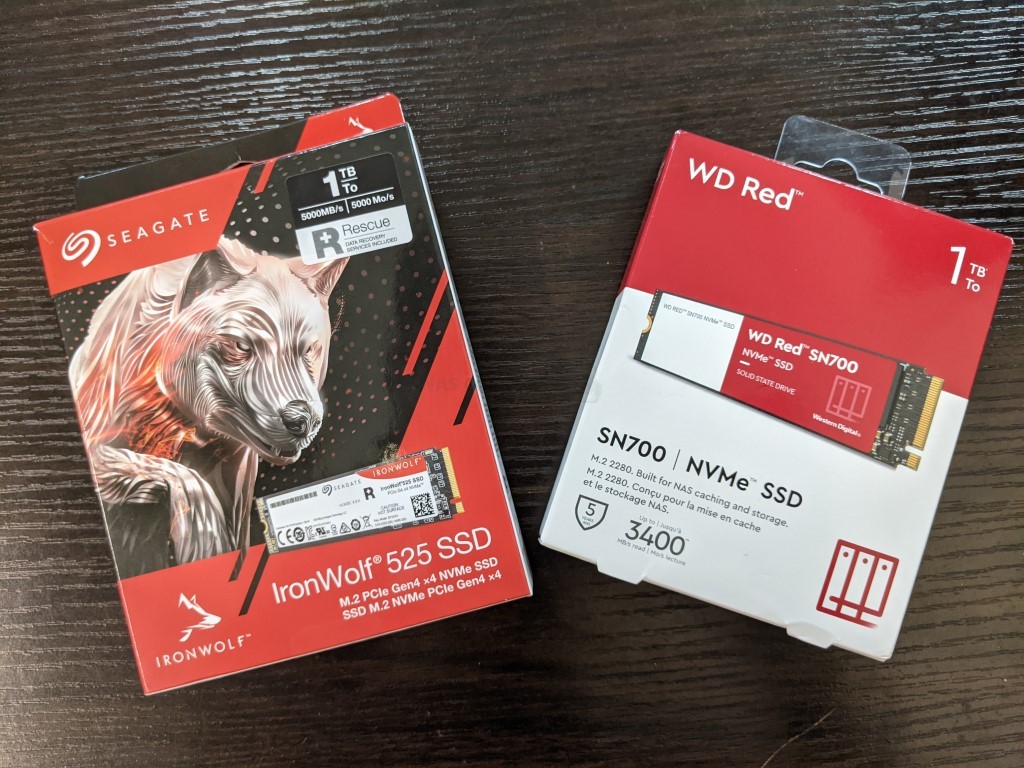
It is worth remembering that the two SSDs in today’s comparison are m.2 NVMe in architecture and although PCIe Gen 4 is compatible with Gen 3 and old, they will not suitable for NAS drives with M.2 SATA connections. We have seen more modern NAS systems released in the last few years abandon m.2 SATA in favour of its PCIe counterpart, but both Seagate and WD both provide SATA alternatives in their Ironwolf and WD Red series. Examples of SATA SSDs for NAS can be found HERE on Amazon.
How do the Seagate Ironwolf 525 and WD Red SN700 SSD Compare on Specs?
Both WD and Seagate are well known for their wide ranges of hard drive and SSD media, as well as both being pioneers of NAS server focused SSDs for caching and flash storage. Although SSDs are all built to a similar ground-level architecture, they will often have their later development shifted in favour of a specific targetted use. This is not a big surprise and much like the cutlery in your kitchen draw, they might be similar but one tool is much better at some tasks than others – ever tried using a spreading butter with a meat-claver? Or stirring tea with a ladle? The Seagate Ironwolf 525 and WD Red SN700 SSD are NAS targetted and although the performance is good, the true stand out factor in this design is the durability of the drive. SSDs for use in NAS systems will in most cases be used for caching and that means a very frequent turnover (i.e. data wrote, updated, deleted, repeat) daily as the demands of client users and devices change. Both of these SSDs arrive with a high level of durability and workload rating, but the WD Red SN700 and Seagate Ironwolf 525 definitely have differing ideas of preliminary architecture and what that price tag is being spent on. Let’s look at the shared base-level SSD architecture of each SSD (available on every capacity):
Below Specifications are taken from official brand sources, data sheets and reputable sources (real-world tests we performed ourselves are a little lower in the article):
| Specifications |
Seagate IronWolf 525 Released September 2021
|
WD Red SN700
Released September 2021
|
| Warranty | 5yr + 3yr Rescue | 5yr |
| MTBF/MTTF | 1800000 | 1750000 |
| PCIe Generation | PCIe Gen 4×4 | PCIe Gen 3×4 |
| NVMe Rev | NVMe 1.3 | NVMe 1.3 |
| NAND | Kioxia BiCS 4 96L 3D TLC NAND | Sandisk 3D TLC |
| Controller | PS5016 SSD Controller | WD NVMe Controller |
As you might know, WD develops practically all of their SSDs ‘in-house’ and feature proprietary NVMe controllers, subsidiary company NAND (in this case Sandisk) and this allows them to be able to control availability and pricing in a way that most other SSD brands cannot. Seagate uses 3rd party controllers and NAND manufacturers for the most part in their ranges, but are still generally quite top tier providers. The release time difference between the WD Red SN700 and Seagate Ironwolf 525 makes an impressive difference here in terms of the hardware on offer on either SSD, with the more recently released Seagate Ironwolf 525 having notably superior connectivity, NAND quality and overall performance. The older WD Red SN700 SSD features 3years of forensic level data recovery services though (which caching NAS users might want to have in the event of ‘trapped data’ during write caching operations and a critical system failure/power-cut) which is very unique to the brand. However, overall the Seagate Ironwolf 525 has superior architecture here. Below is how the building blocks of the Seagate Ironwolf 525 and WD Red SN700 result in throughput, IOPS and Durability at each capacity tier (based on officially provided figures):
| Model |
Seagate IronWolf 525 Released September 2021
|
WD Red SN700 Released September 2021
|
| 240/250GB | N/A | WDS250G1R0C – $55 |
| Sequential Read (Max, MB/s), 128 KB | N/A | 3,100MB |
| Sequential Write (Max, MB/s), 128 KB | N/A | 1,600MB |
| 480/500GB | ZP500NM30002 – $99 | WDS500G1R0C – $79.99 |
| Sequential Read (Max, MB/s), 128 KB | 5000MB / 3400MB | 3,430MB |
| Sequential Write (Max, MB/s), 128 KB | 2500MB / 2500MB | 2,600MB |
| 960/1000GB | ZP1000NM30002 – $179 | WDS100G1R0C – $152.99 |
| Sequential Read (Max, MB/s), 128 KB | 5000MB / 3400MB | 3,430MB |
| Sequential Write (Max, MB/s), 128 KB | 4400MB / 3200MB | 3,000MB |
| 1920/2000GB | ZP2000NM30002 – $369 | WDS200G1R0C – $289.99 |
| Sequential Read (Max, MB/s), 128 KB | 5000MB / 3400MB | 3,430MB |
| Sequential Write (Max, MB/s), 128 KB | 4400MB / 3200MB | 2,900MB |
| 3840/4000GB | N/A | WDS400G1R0C – $649.99 |
| Sequential Read (Max, MB/s), 128 KB | N/A | 3,430MB |
| Sequential Write (Max, MB/s), 128 KB | N/A | 3,100MB |
| 240/250GB | N/A | WDS250G1R0C – $55 |
| Random Read (Max, IOPS), 4 KB QD32 | N/A | 220K |
| Random Write (Max, IOPS), 4 KB QD32 | N/A | 180K |
| 2480/500GB | ZP500NM30002 – $99 | WDS500G1R0C – $79.99 |
| Random Read (Max, IOPS), 4 KB QD32 | 420K / 420K | 420K |
| Random Write (Max, IOPS), 4 KB QD32 | 630K / 550K | 380K |
| 960/1000GB | ZP1000NM30002 – $179 | WDS100G1R0C – $152.99 |
| Random Read (Max, IOPS), 4 KB QD32 | 760K / 640K | 515K |
| Random Write (Max, IOPS), 4 KB QD32 | 700K / 565K | 560K |
| 1920/2000GB | ZP2000NM30002 – $369 | WDS200G1R0C – $289.99 |
| Random Read (Max, IOPS), 4 KB QD32 | 740K / 640K | 480K |
| Random Write (Max, IOPS), 4 KB QD32 | 700K / 565K | 540K |
| 3840/4000GB | N/A | WDS400G1R0C – $649.99 |
| Random Read (Max, IOPS), 4 KB QD32 | N/A | 550K |
| Random Write (Max, IOPS), 4 KB QD32 | N/A | 520K |
| Heatsink Option | No | No |
| TBW Rating | 700/1400/2800 | 3,430MB |
| DWPD Rating | 0.7 DWPD | 0.7-1.0 DWPD |
| Note – BLUE Text is the Seagate Ironwolf 525 on a PCIe Gen 3×4 Slot |
|
Overall, it should come as no surprise that the Seagate Ironwolf 525 SSD is the notable leader here in practically all official benchmarks over the slightly older WD Red SN700 SSD, thanks to that improved architecture. Most notably in write performance and IOPS in general, it had a clear lead even in the lowest available capacities. Of course, these are officially provided performance figures and represent maximums based on the highest available hardware at the time of release. Let’s take a look at how these two SSDs compare in our own tests.
How Did the WD Red SN700 and Seagate Ironwolf 525 SSD Compare in OUR Tests?
Moving away from the official performance stats provided by WD and Seagate, I wanted to see how the Seagate Ironwolf 525 and WD Red SN700 compared in my own tests. Testing of these two SSDs will be broken down into 3 main parts, a CrystalDisk Benchmark test, Atto Disk Benchmark Test and an AJA media test. In each test, the SSD was in the 2nd storage slot (i.e not the OS drive). Each test was conducted three times and the system was left for 1 minute between tests to allow the SSD time to stabilize. The specifications of the test machine are:
Test Machine:
- Windows 10 Pro Desktop System
- Intel i5 11400 Rocket Lake – 6-Core 2.6/4.4Ghz
- 16GB DDR4 2666MHz Memory
- Intel B560M mATX Motherboard
- OS Storage, Seagate Firecuda 120 SSD
- Test SSD connected to Secondary PCIe Gen 4×4 M.2 Slot
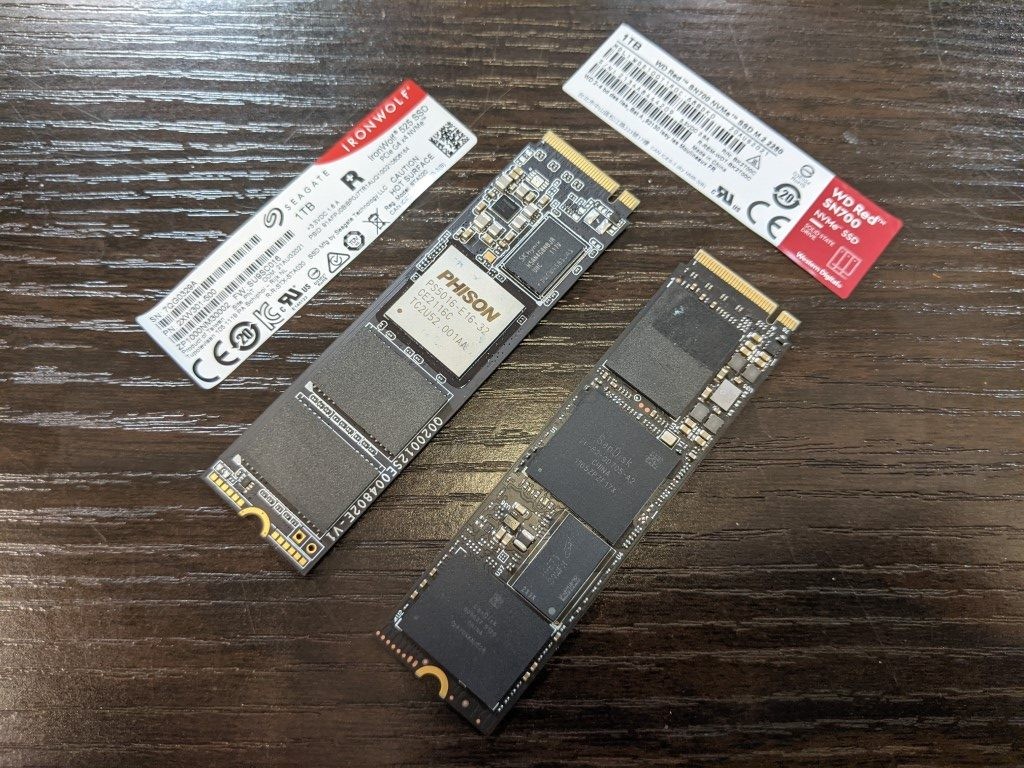
CrystalDisk 1GB Test File – Read, Write, 70/30% Mixed and IOPS Performance
CrystalDisk is still highly regarded as one of the most reliable tools for measuring storage media performance. Though it does create somewhat high-end results that may not be truly indicative of your own real-world setup, it can be used to display maximum potential throughput and IOPs at each tier. The first test for the Seagate Ionwolf 510 and Seagate Ironwolf 525 was on a 1GB test file:
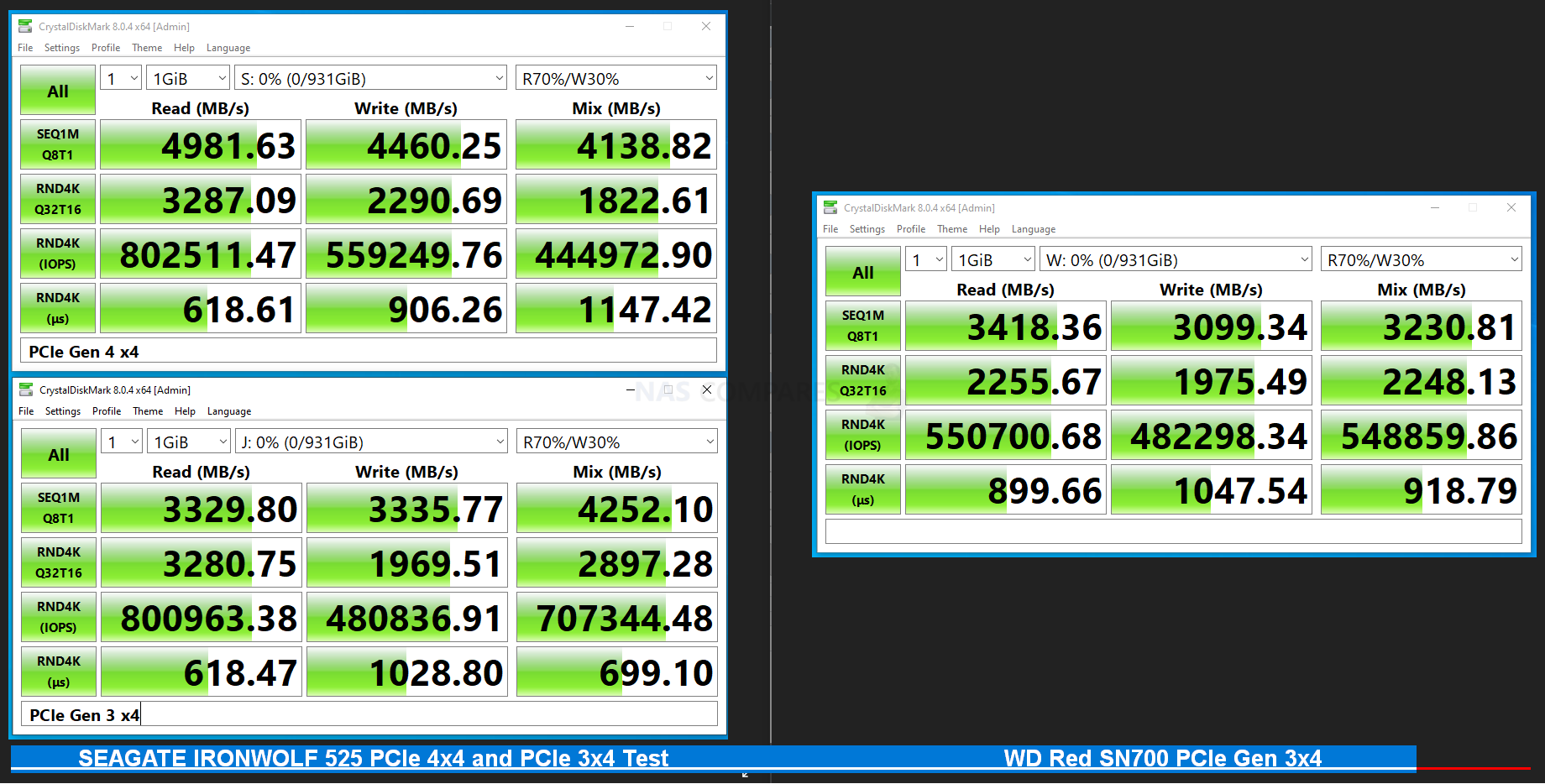
Overall Winner: The Seagate Ironwolf 525 Overall
CrystalDisk 4GB Test File – Read, Write, 70/30% Mixed and IOPS Performance
The next test was to perform the same parameters in CrystalDisk on the Seagate Ironwolf 525 and WD Red SN700, but this time with a 4GB test file (larger files may result in higher sequential performance, but lower comparative IOPS)
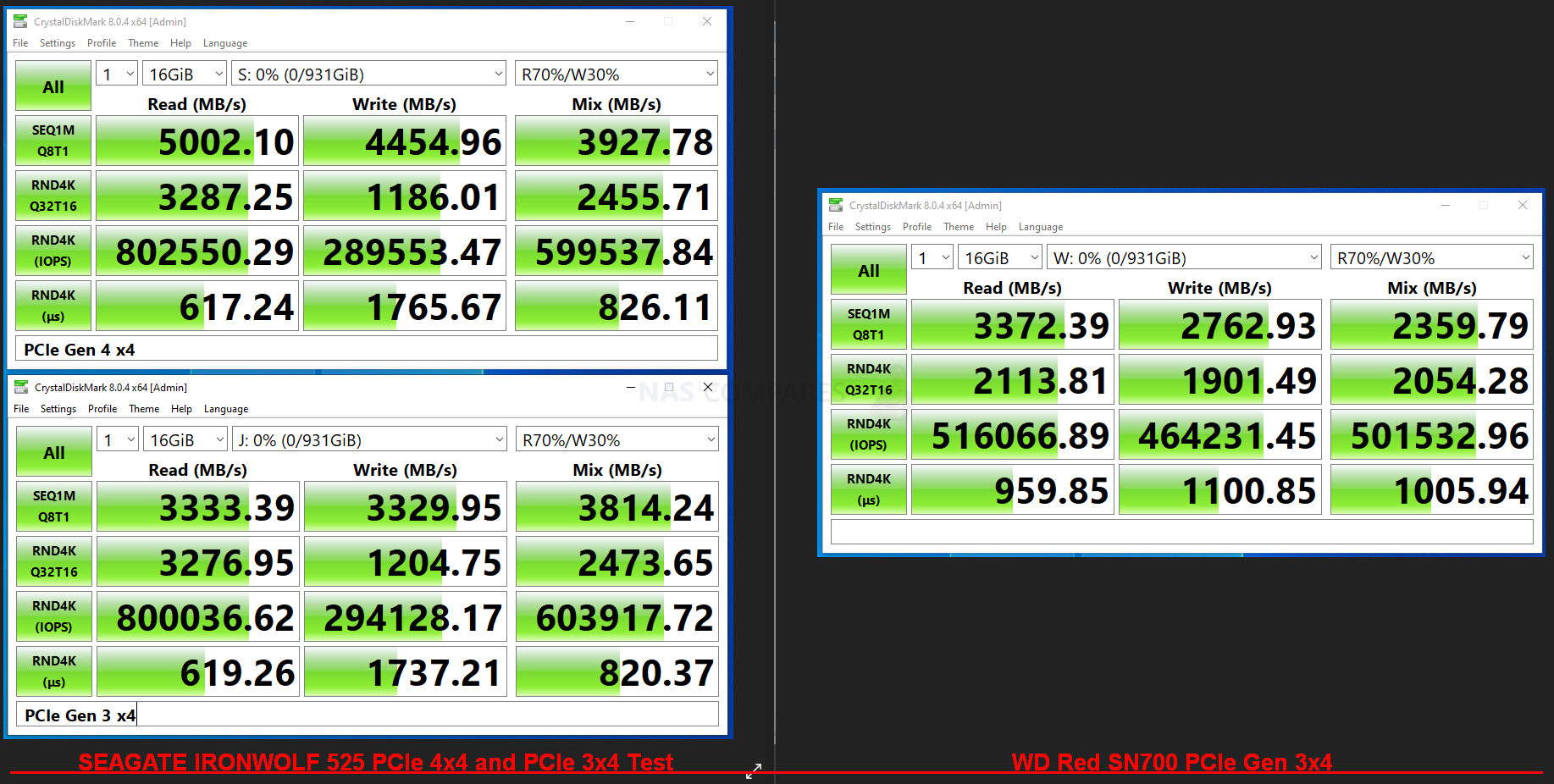
Overall Winner: The Seagate Ironwolf 525 Overall
ATTO DiskBenchmark 1GB Test File – Read, Write
Switching things up, I then moved testing the WD Red SN700 and Seagate Ironwolf 525 SSD over to ATTO disk benchmark. A far more detailed tool that spreads performance testing over different file and block sizes. I started with the smallest ‘full range’ test file of 1GB. Here is how each SSD compared:
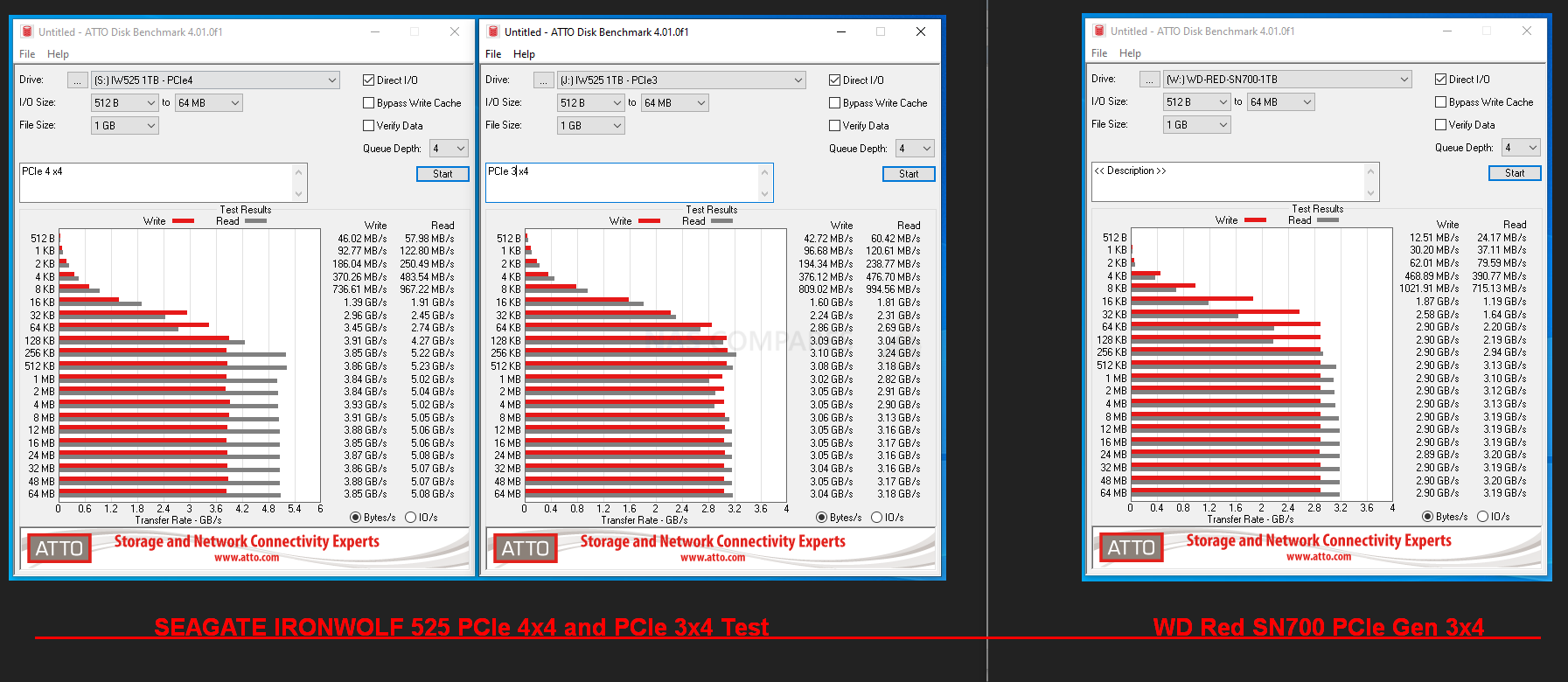
Overall Winner: The Seagate Ironwolf 525 Overall
ATTO DiskBenchmark 4GB Test File – Read, Write
Sticking with ATTO DiskBenchmark, I then moved the testing of the Seagate Ironwolf 525 and WD Red SN700 onto a x16 bigger test file of 4GB. This would certainly shift where the peaks in performance would sit and hopefully produce a clearer disparity between these two SSDs:
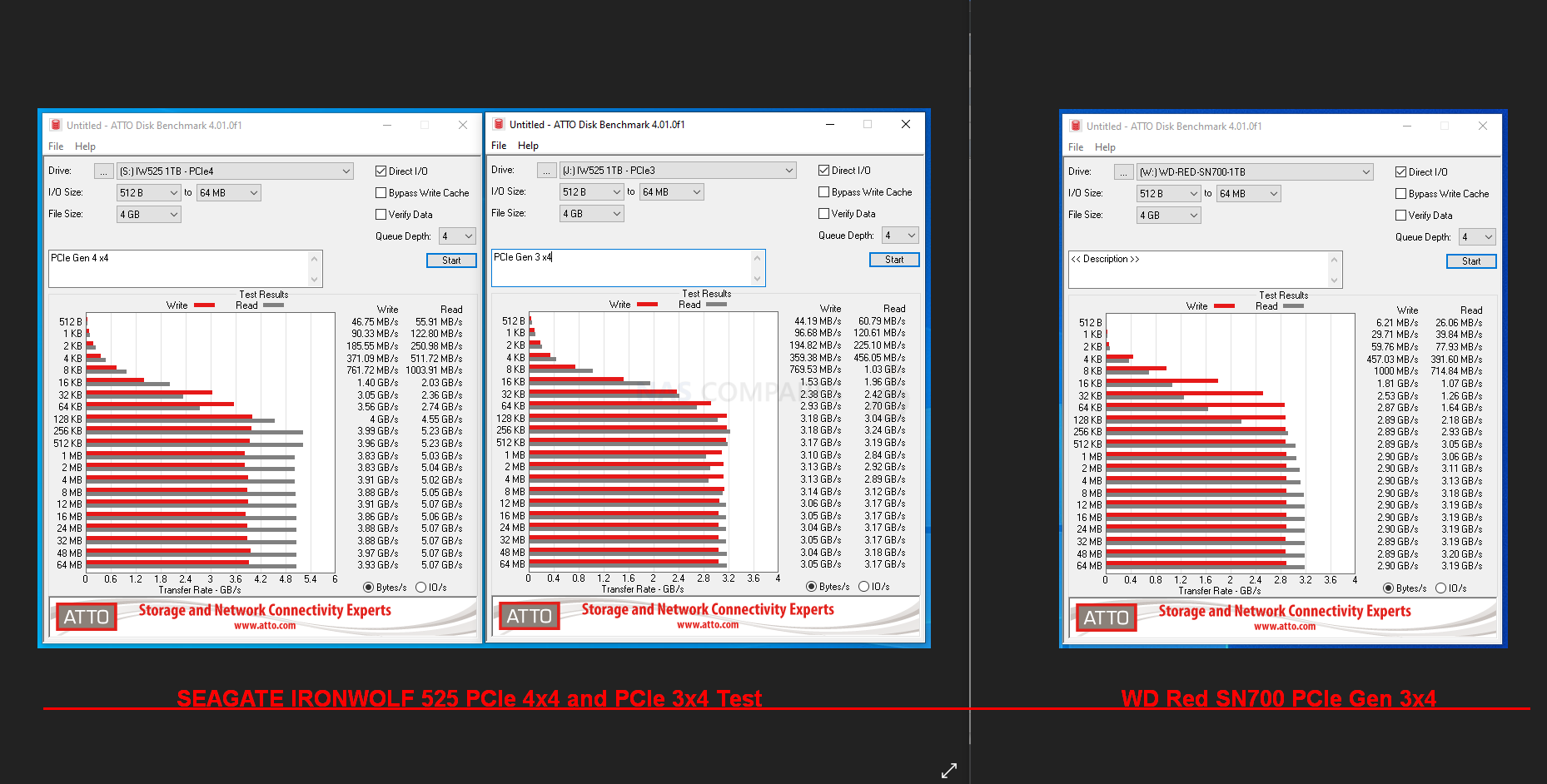
Overall Winner: A Draw
AJA 1080i Media Test 1GB Test File – Read, Write
I then switched to AJA, a popular media testing tool for video formats. Most SSDs will suffer over-saturated Memory/DRAM/SDRAM as sustained large file tests go on. The 1GB file test of AJA on the Seagate Ironwolf 525 and WD Red SN700 is still a small enough value not to be a problem though and we chiefly focused on the disk playback/reads graph to see how they compared in peak performance and also throughout the transfer:
| Seagate Ironwolf 525 SSD
|
| WD Red SN700 SSD
|
Overall Winner: A Draw
AJA 1080i Media Test 16GB Test File – Read, Write
Then we used a much, MUCH heavier test in AJA of 16GB on the WD Red SN700 and Seagate Ironwolf 525 SSD. Unsurprisingly this can often overflow the SSD cache/memory on board and result in a dip in performance as the SSD bottlenecks internally. So, when conducting this test, we are looking at peak performance AND how long the SSD maintained that performance before a potential dip. Here is how these two SSD compared:
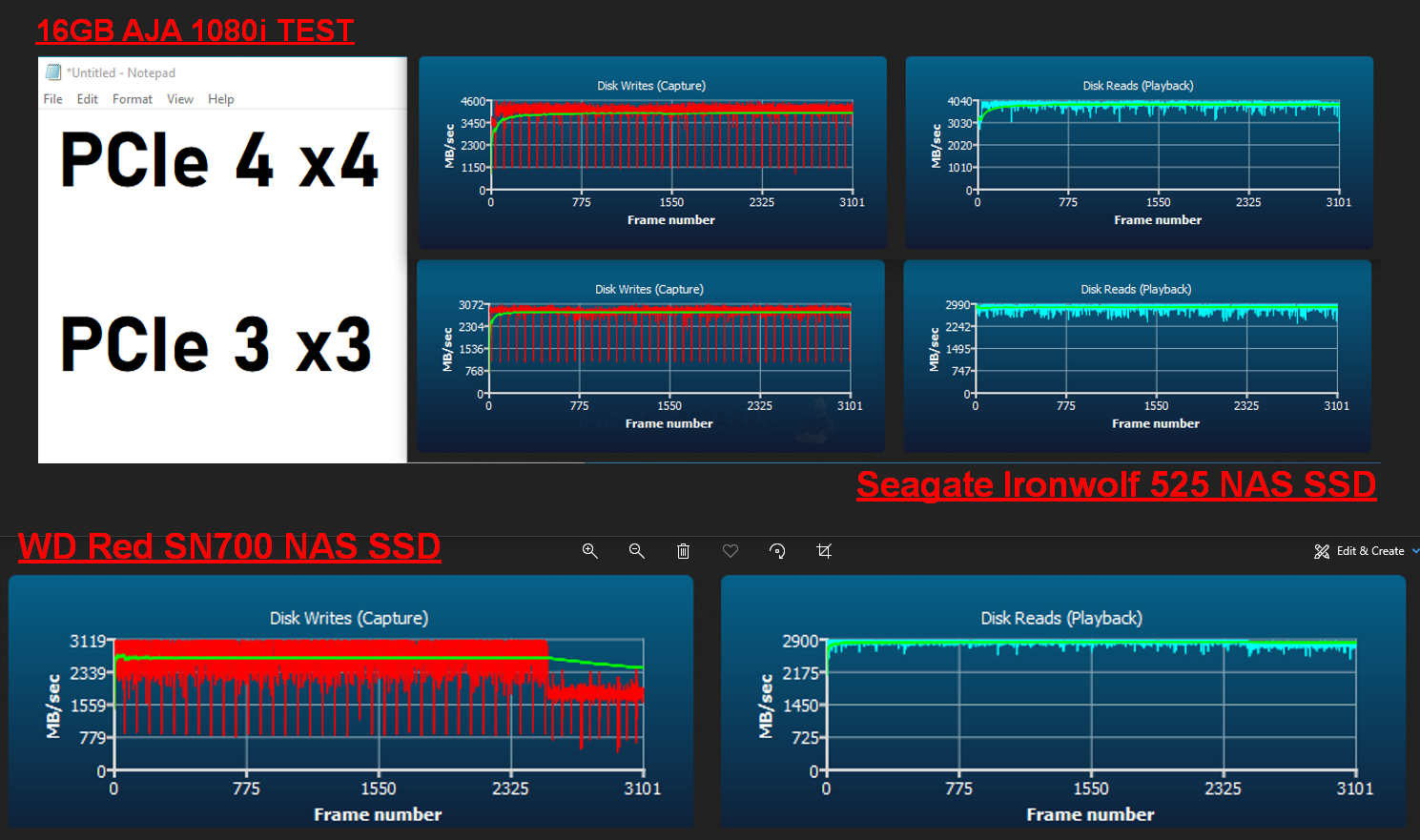
Overall Winner: The Seagate Ironwolf 525 Overall
Seagate Ironwolf 525 vs WD Red SN700 SSD – The Results
Both the Seagate Ironwolf 525 and the WD Red SN700 are great examples of NVMe SSDs that will be remarkably useful in your NAS. With both drives largely saturating a PCIe Gen 3×4 SSD connection, arriving with a high level of durability and Throughput+ IOP performance that will certainly see your hard drive storage pool improve in it’s transfers with clients, whichever one you choose is going to be a great fit. That said, it is impossible to ignore that the Seagate Ironwolf 525 is overall the better SSD choice in the majority of ways. With its support of PCIe 4 and PCIe 3, matching the same connectivity performance on the WD Red SN700, the Seagate Ironwolf pulls further ahead with higher IOPS performance and that inclusive forensic data recovery services included. That said, it is by no means a clean sweep by Seagate here, with the WD Red SN700 arriving in more capacities (adding a smaller 250GB and larger 4TB model to the series), as well as a better price point at every tier and the same/higher durability as the Seagate Ironwolf at all storage sizes. As mentioned, both of these SSDs are great examples of what users should look for in an SSD for their old/new NAS system in order to improve the performance of cheaper, larger but slower hard drives.
| The Seagate Ironwolf 525 NVMe SSD Wins on:
|
The WD Red SN700 NVMe SSD Wins on:
|
📧 SUBSCRIBE TO OUR NEWSLETTER 🔔
🔒 Join Inner Circle
Get an alert every time something gets added to this specific article!
This description contains links to Amazon. These links will take you to some of the products mentioned in today's content. As an Amazon Associate, I earn from qualifying purchases. Visit the NASCompares Deal Finder to find the best place to buy this device in your region, based on Service, Support and Reputation - Just Search for your NAS Drive in the Box Below
Need Advice on Data Storage from an Expert?
Finally, for free advice about your setup, just leave a message in the comments below here at NASCompares.com and we will get back to you. Need Help?
Where possible (and where appropriate) please provide as much information about your requirements, as then I can arrange the best answer and solution to your needs. Do not worry about your e-mail address being required, it will NOT be used in a mailing list and will NOT be used in any way other than to respond to your enquiry.
Need Help?
Where possible (and where appropriate) please provide as much information about your requirements, as then I can arrange the best answer and solution to your needs. Do not worry about your e-mail address being required, it will NOT be used in a mailing list and will NOT be used in any way other than to respond to your enquiry.

|
 |
#RunWithIronWolf and #WDRedNAS . This unit was supplied by @seagate and @WesternDigitalCorporation .The review provided was free of bias and my own independent opinions
A Buyer's Guide to Travel Routers - GET IT RIGHT, FIRST TIME
Jonsbo N6 DIY NAS Case Review
The Best Bits (and Worst Bits) of NAS of 2025!
Minisforum MS-02 Ultra Review
Minisforum N5 NAS, 6 Months Later - Better, Worse, the Same?
Beelink ME Pro NAS Revealed
Access content via Patreon or KO-FI





Discover more from NAS Compares
Subscribe to get the latest posts sent to your email.


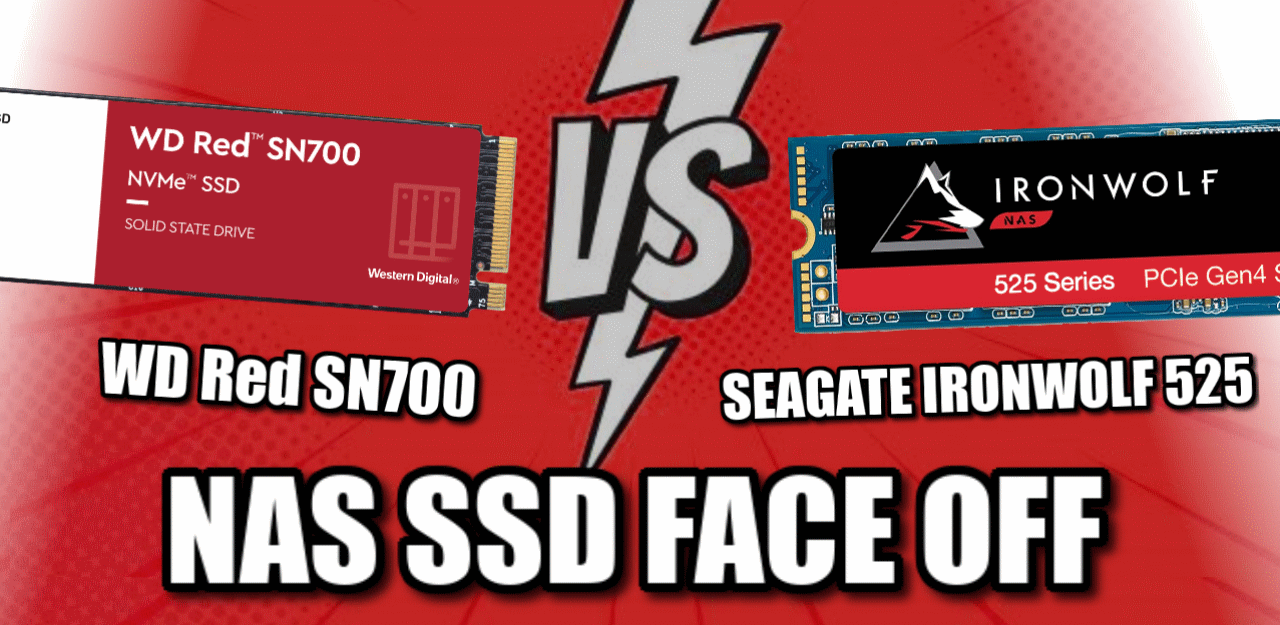








What if I put 2 x SSD for cache in RAID 1? Am I in danger to loose the cache files in case something happens?
REPLY ON YOUTUBE
Why does the WD red have so much TBW. What is the difference in memory cells?
REPLY ON YOUTUBE
Why does all English Speaker sound like Micky Mouse on Speed?
REPLY ON YOUTUBE
I know I’m watching this about 8 months from release but what I would have found useful is if you’d compared both the seagate gen4 drive and wd red gen3 drive against the seagate gen3 drive that you had in the background, I think that would have helped emphasize the gen3 to gen4 improvement as well as emphasize the differences between wd’s board layout compared to seagates.
REPLY ON YOUTUBE
I enjoyed the comedy session !
REPLY ON YOUTUBE
Haha. He’s got jokes. ????
REPLY ON YOUTUBE
The comparison that haunted me the most would be WD Red SN700 vs WD_Black SN750, these two are just so alike.
REPLY ON YOUTUBE
Nice talk in general, great job! A couple points to note: Phison E16 are not the best/fastest gen.4 controllers available on the market currently. I hope Seagate would update their model to E18 controller. Second point talking about controllers – in order for greater quantity of NAND chips to be beneficial it is mandatory for controller to have enough channels to handle that amount of flash chips. For budget controllers nowadays it could be as low as two channels which would make using four chips of flash the same in a good case and potentially might be even worse compared to using two flash chips. For better controllers with four channels four chips are best case in general, e.t.c. That’s the reason why some top capacity models available are sometimes perform somewhat slower compared to the same model but with lesser capacity. TL/DR here is that for a picky and knowledgeable buyer it is really important to know controller type, capabilities and NAND type and chips amount for the device they buy. For a less geeky chap it’s probably good enough to simply choose the model based of target placement (ex. for WD – green vs blue vs red vs black) and to stick with the middle capacity alongside available in chosen model lineup.
REPLY ON YOUTUBE
For a home user, performance is almost irrelevant. It is much more about durability and storage space. I couldn’t care less if it’s PCIe 3.0 or PCIe 4.0.
REPLY ON YOUTUBE
Wow. Nice job.
REPLY ON YOUTUBE
Does anyone know how I interpret Synology’s cache advisor. It’s suggesting 480 GBs of cache but does that mean 480 in total? or 480 per slot? (I have two cache slots on my 920+).
REPLY ON YOUTUBE
Audio is too quiet on this one.
REPLY ON YOUTUBE
will these work in the ps5
REPLY ON YOUTUBE
Thank you ????
REPLY ON YOUTUBE
Can I use PCI-e 4 SSD in QNAP that supports PCI-e 3?
REPLY ON YOUTUBE
Definitely see a new series of videos from this
REPLY ON YOUTUBE
*Chapters*
00:00 – Awful Computer Jokes
00:36 – The Beginning
01:52 – NAS SSDs? Why They Are a Thing
05:00 – How The Seagate Irownolf 525 and WD Rd SN700 SSDs Tech Specs Compare?
10:58 – How the WD Rd SN700 & Seagate Ironwolf 525 SSD Compare in Price
12:45 – The Tortoise and the Hare Release Schedule
14:17 – SSD Design and How WD & Seagate Went Different Ways
16:41 – Published Throughput & IOPS on the Red SN700 and Ironwolf 525 SSD
18:35 – NASCompares Test Results & Benchmarks on the Ironwolf 525 and Red SN700
20:00 – NAS Performance Tests Brief Summary (see dedicated vids for further info)
20:49 – WD Red vs Seagate Ironwolf 525 SSD – Verdict & Conclusion
REPLY ON YOUTUBE
*Chapters*
00:00 – Awful Computer Jokes
00:36 – The Beginning
01:52 – NAS SSDs? Why They Are a Thing
05:00 – How The Seagate Irownolf 525 and WD Rd SN700 SSDs Tech Specs Compare?
10:58 – How the WD Rd SN700 & Seagate Ironwolf 525 SSD Compare in Price
12:45 – The Tortoise and the Hare Release Schedule
14:17 – SSD Design and How WD & Seagate Went Different Ways
16:41 – Published Throughput & IOPS on the Red SN700 and Ironwolf 525 SSD
18:35 – NASCompares Test Results & Benchmarks on the Ironwolf 525 and Red SN700
20:00 – NAS Performance Tests Brief Summary (see dedicated vids for further info)
20:49 – WD Red vs Seagate Ironwolf 525 SSD – Verdict & Conclusion
REPLY ON YOUTUBE